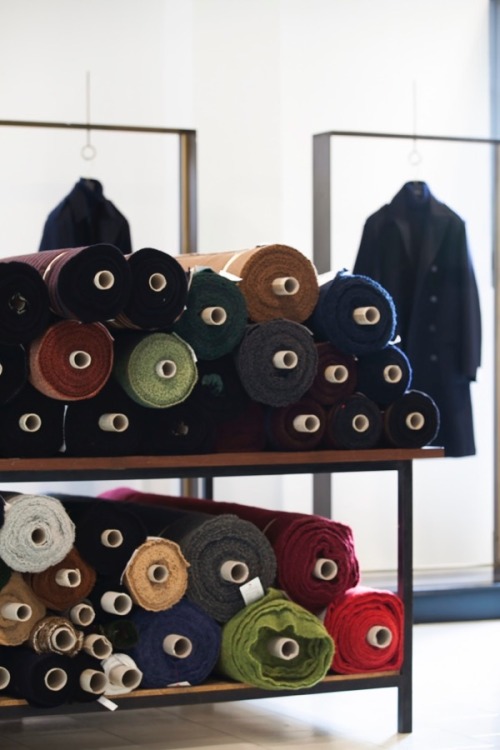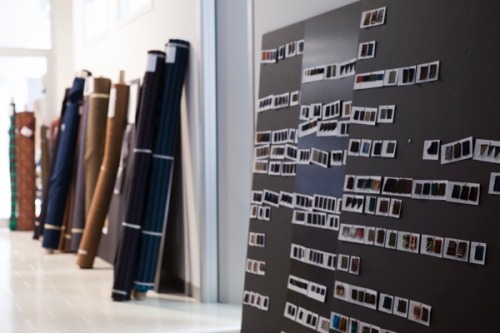No Man Walks Alone is delighted to be carrying DoppiaA. In this interview, designer Alain Fracassi explains his style philosophy.
David Isle of No Man Walks Alone: How did your interest in style begin?
Alain Fracassi: In reality, for me it’s much more than a simple interest but something that makes up part of the DNA of my family for at least three generations. I have been fortunate to inherit the taste for dressing well from my tailor grandfather first, then from my father, and today I continue with love and cultivate it on my own.
NMWA: Does your personal style change often or stay more less the same?
AF: Style never changes. Details change, attitudes change, the functions change, but style can never change. Style is there or it isn’t.
NMWA: What’s your process for creating a collection? Do you begin with a theme and go from there? Or perhaps a particular fabric or cut?
AF: Content and form, for me, travel in parallel and can be reciprocally stimulating. At times, in terms of inspiration, a fabric can be determinative in designing a garment, other times vice versa, it’s the very characteristics of the garment that determine the selection of the fabric. If you want to surprise, you have to learn how to surprise yourself.

NMWA: I see in your clothes an interesting and sophisticated use of color. How did you develop this appreciation of rarer colors? What advice would you give to someone who wants to experiment with colors other than the usual gray and blue?
AF: I would say it’s simply an authentic passion that through the years I have developed and deepened. The world of colors is for me a source of great enthusiasm, but also an extremely fertile way to play and mix up the deck of cards of formal and informal stereotypes. Color is the joy of life, fun, and happiness. It can be ironic and self-deprecating.
To a man who hasn’t gone beyond blue and gray, I would suggest: say it with color, just like the old saying goes, say it with flowers.
NMWA: When you imagine the final product, do you think about who will wear it? Where they will wear it? Do you design clothes for particular occasions?
AF: DoppiaA was born with the intention of “dressing gentlemen of every generation.” For us elegance and style don’t have an age nor a social justification, but are transcendent values, important and both inclusive and exclusive at the same time.
NMWA: You have much experience not only in style but in the business of style. How have you seen the industry change in the last 10-20 years?
AF: I would say the biggest changes are due to globalization and the development of new markets for Western style and fashion. I hope that the trade war between China and the U.S. does not go beyond good sense and inhibit the free flow of trade and ideas.

NMWA: What do you think distinguishes Italian style? Is there one Italian style or, as with dialects, must we speak only of a collection of regional styles?
AF: In effect the richness of Italian culture is exactly the collection of many realities that go along with it. You mention dialects, but I could also use the example of regional cuisines. In the case of style, this heterogeneity is sublimated in a commonality that everyone recognizes and exists on the same plane as, say, British or French style, and distinguished by its naturalness and aloofness. Without forgetting that the suits of a certain quality appeared in our mistreated boot before anywhere else.
NMWA: That “naturalness and aloofness” that you describe - are those qualities that are difficult to design? Those qualities seem almost to demand a lack of design, or at least a seeming lack of design.
AF: By naturalness and aloofness I mean that which, for me, represents the essence of dressing and of Italian sartorial elegance: to feel at ease in suits of quality make, made from fabrics of high quality in any moment of the day and in any situation. To be distinguished without being garish. In a certain sense it’s not so much absence of design as breaking the chains of design in favor of good living and good dressing.

NMWA: How do you view the connection between your clothes and the style of the past? Do you try to recall that style? Continue it? Advance it?
AF: As the natural evolution of the formal and the informal. To advance, to remember, to meet the daily challenges of contemporary life.
NMWA: What do you see for the future? We often hear of the death of the suit, but it still survives. Does it have little time left? Or will it continue to help us to meet the challenges of contemporary life?
AF: I believe the essence of dressing will remain unchanged in the coming years. The world certainly will change, like the materials that we use to protect ourselves from climate change and environmental pollution, but not the ways in which a man can place himself within a social context. The suit, in a certain sense, is like a calling card, it’s the easiest way we have to say who we are, without saying it.